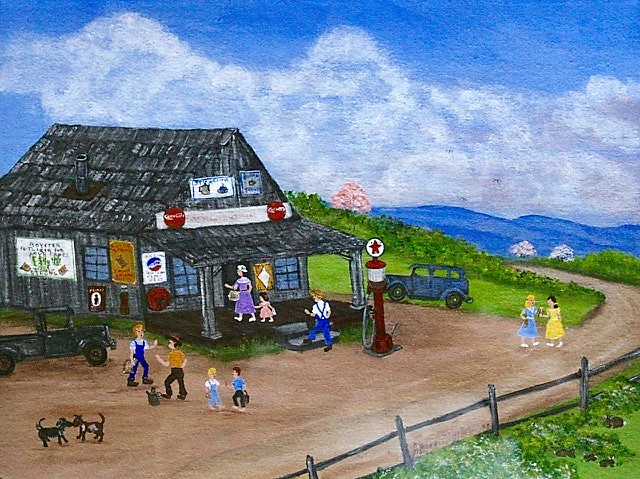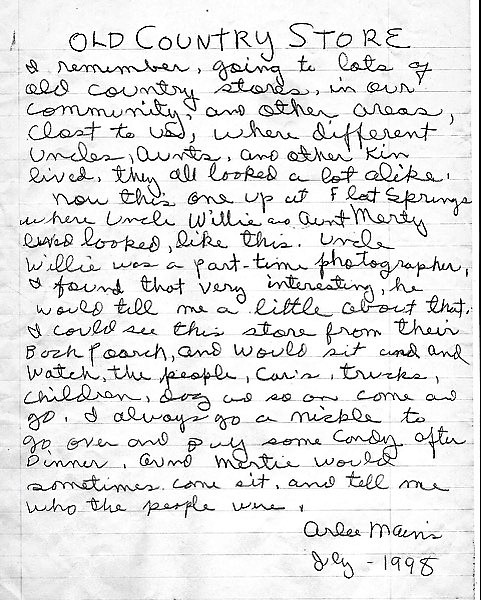

A self taught artist, Arlee Trivett Mains painted memories of her childhood and family in the Blue Ridge Mountains during the 1930s, 40s and 50s. True to her storytelling nature, Arlee also wrote down her memories to go with each painting.
Arlee was born in Zionville (also called Windy Gap) in the Appalachian mountains, on the northern edge of Watauga County. She remembered her childhood as idyllic, living among relatives with numerous cousins for playmates. Although art for its own sake was a frivolity there, childhood creativity was encouraged, especially as diversions at family gatherings. Arlee recalled how “the older people would take the bored children out to the barn. There were always corn chucks, and the adults would show us how to use them to make a toy – a dog, a corn stalk horse, a doll. … We used tree sap for glue, a burnt stick for a pencil … whatever was handy. They’d show us how to put on a doll’s eyebrows, its nose. For years I thought that was how you made faces, then I made my own kind of face later.” Arlee treasured that place; and the memory of its river, its fields, its lanes, would eventually be what she chose to paint.
Arlee Mains, Rabbit Hunters.
And yet, the region was among the poorest in North Carolina: by the 1960’s, 58% of families in the four-county WAMY region (Watauga, Avery, Mitchell and Yancey) had incomes below federal poverty levels. One source of meagre income for these families was from crafts such as the corn husk dolls. Then in the mid-1960’s, Federal War on Poverty money started trickling into the WAMY region; and Arlee’s aunt Ina Hagaman correctly recognized that with that outside attention, both she and Arlee could begin to earn “real” money from their crafts. Indeed, some of Hagaman’s early corn husk dolls eventually ended up in the Smithsonian. Arlee, however, observed that “I never did get the hang of it – to make the dolls look like hers.” She developed her own successful style of doll, but also came to understand that what she really wanted to do was paint.
As a girl, Arlee drew with a pencil in books, brown bags, “every piece of plunder I could find.” When she was twelve, her parents bought her a set of Sears-Roebuck oils that came without instructions. She had one piece of canvas that she painted on again and again and again while trying to learn. She read how-to books, and finally did figure it out sort of. People were constantly discouraging her, however, in school and later too, telling her that few women had ever made anything, especially money, out of art, and it was useless to try. “Yet my body wouldn’t accept that. I wanted to paint, had to paint.”
And she kept reading, kept sketching, kept studying the paintings of others. But, “The way they did their paintings did not please me. I didn’t want my pictures to look fuzzy. Impressionism. Whatever. I didn’t care for pots of flowers. I couldn’t relate to that. My mind knew that I needed to paint things that I knew about, but I didn’t yet realize that. … Finally I decided that I’m going to paint that old church [at home] just like I remember it. And that’s what I did. When the canvas was finished I liked it. That’s what started me to painting like I paint. I paint things I remember.” By her 60’s, Arlee’s primitive oils were selling faster than she could turn them out.
Between April 23 and July 24, 2016, a selection of Arlee’s paintings on loan from the Art Cellar Gallery in Banner Elk NC and other local collectors were on display at HMA. At the opening reception on June 23rd, Arlee signed copies of her book Memories of Appalachia: Paintings and Stories by Arlee Mains. Please contact The Art Cellar Gallery with inquiries about her book.
HMA promotes and shares folk art through its annual folk art festival. A packet of information about sponsoring that festival can be found here.
Principal source for this post: The Keepers: Mountain Folk Holding on to Old Skills and Talents, by Robert Isbell with photographs by Arthur Tilley. 1999.
This post is # 29 of the 75 stories to celebrate HMA's 75 years.
Post by Karin Borei, HMA Project Coordinator, writer and editor as needed, and HMA blogger since our blog's inception in March 2015.



